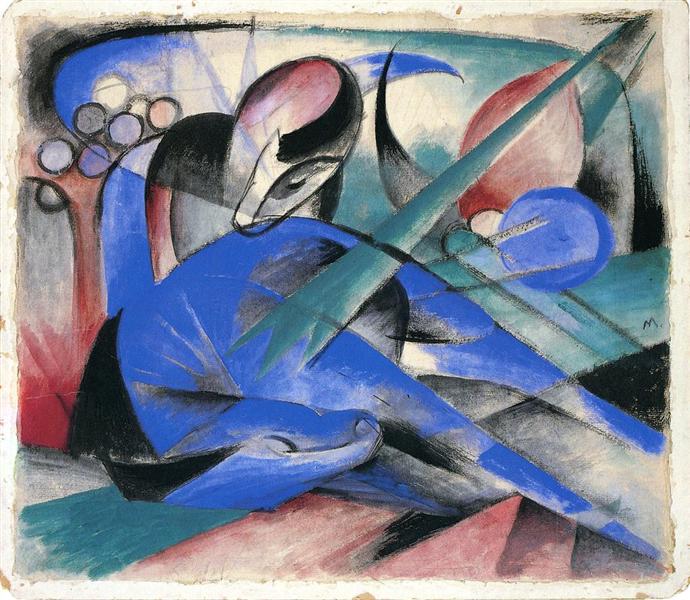Description
Franz Marc's "sleeping horse" painting, made in 1913, is a work that encapsulates the essence of German expressionism and reflects the deep emotional connection that the artist established with the animal world. This piece is representative of Marc's distinctive style, who is known for his exploration of symbolism and bold color use. At first glance, the work focuses on the image of a horse that sleeps, a figure that not only evokes a sense of calm, but also invites a deeper meditation on the relationship between the human being and nature.
The composition of "sleeping horse" is dynamic and fluid, with lines that seem to take the viewer through the body of the horse and towards the bottom of the canvas. The animal's shape is stylized, presenting soft edges that contrast with the intensity of the colors used. Marc opts for a background toned in green and yellow, which suggests a natural environment, while the horse's body stands out with a symbolic creation of shapes and colors. The use of blue and yellow in the figure of the horse not only provides an attractive visual contrast, but also reflects Marc's approach towards the use of color as a means to express the spirituality and emotional vibration of the subjects he portrays.
The horse, one of the recurring themes in Marc's work, symbolizes purity and freedom in the context of his artistic exploration. The gentleman or rider, a figure that could have been graceful in other works, is not present here, which suggests an emancipation of the animal of human control. This absence of the human figure can also be interpreted as a comment on the need for greater harmony between human beings and nature in a time of growing industrialization and alienation.
Marc's work is registered within a broader movement of expressionism, where artists sought to break the restrictions of realism and explore new forms of representation. Inspired by symbolism and the search for a spiritual world, Marc developed an aesthetic where colors are not only visual, but also emotional and spiritual. The unique combination of vibrant colors in "sleeping horse" is a reflection of this, since each tone seems to have a particular resonance that appeals to the sensory perception of the spectator.
In a broader context, "sleeping horse" can dialogue with contemporary works from other artists of their time that also explored the relationship between man and nature. For example, the works of Paul Klee or even his contemporaries in the expressionist movement, who shared the obsession with the representation of the world through symbolic and emotional lenses. Marc's work stands out for his peculiar sensitivity to the essence of the animal and his intrinsic beauty.
From a historical perspective, "sleeping horse" is a manifestation of Marc's role within the first developments of modern art, where his visual and conceptual choices deeply hit the way in which later artists conceived their works. Although the context in which it was created reflects an era of change and agitation in Europe, painting is erected as a testimony of the search for peace and connection with nature.
"Sleeping horse" is a song to freedom, stillness and beauty of the natural, and with it, Franz Marc offers the viewer not only an image of a sleeping horse, but an invitation to reflect on our own place in the world and the need for harmony in an increasingly discordant environment.
KUADROS ©, a famous paint on your wall.
Hand-made oil painting reproductions, with the quality of professional artists and the distinctive seal of KUADROS ©.
Art reproduction service with satisfaction guarantee. If you are not completely satisfied with the replica of your painting, we refund your money 100%.

